LONG HAUL.
Page 36
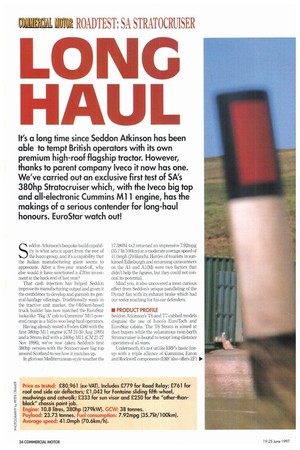
Page 38
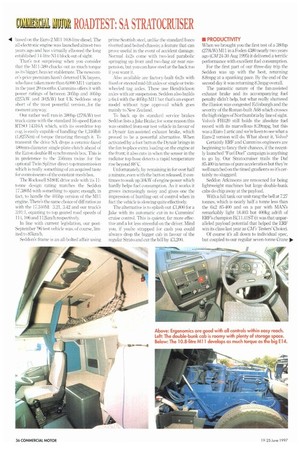
Page 40
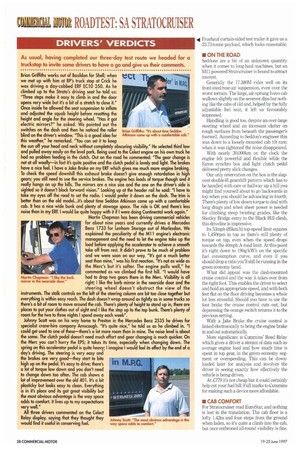
Page 41
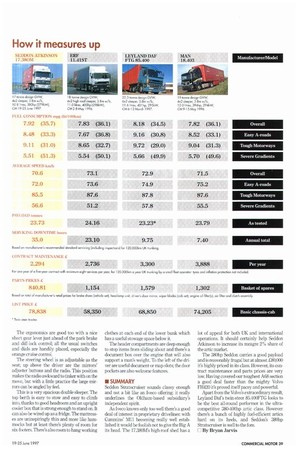
Page 39
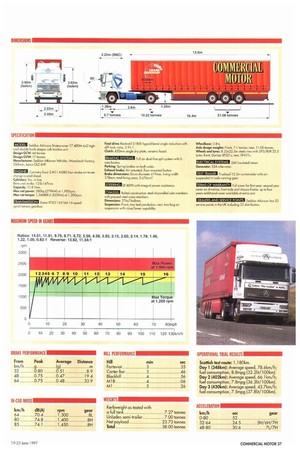
If you've noticed an error in this article please click here to report it so we can fix it.
!MIL' rfilt DIU ROADTEST: SA STRATOCRUSER
It's a long time since Seddon Atkinson has been able to tempt British operators with its own premium high-roof flagship tractor. However, thanks to parent company Iveco it now has one. We've carried out an exclusive first test of SA's 380hp Stratocruiser which, with the Iveco big top and all-electronic Cummins M1 1 engine, has the makings of a serious contender for long-haul honours. EuroStar watch out!
Seddon Atkinson's bespoke-build capability is what sets it apart from the rest of the Iveco group, and it's a capability that the Italian manufacturing giant seems to appreciate. After a five-year stand-off, why else would it have sanctioned a £20m investment at the back end of last year?
That cash injection has helped Seddon improve its manufacturing output and given it the confidence to develop and garnish its general-haulage offerings. Traditionally weak in the tractive unit market, the Oldham-based truck builder has now matched the EuroStar lookalike "Big A" cab to Cummins' Mil-powered range in a bid to woo long-haul operators.
Having already tested a Foden 4380 with the first 380hp Mll engine (CM 24.30 Aug 1995) and a Strato 4x2 with a 340hp Mll (CM 21-27 Nov 1996), we've now taken Seddon's first 380hp version with the Stratocruiser big top around Scotland to see how it matches up.
In glorious Mediterranean-style weather the 17.380M 4x2 returned an impressive 7.92mpg (35.7 lit/100km) at a moderate average speed of 41.0mph (70.6km/h). Hordes of tourists in sun kissed Edinburgh and returning caravanners on the Al and Al(M) were two factors that didn't help the figures, but they could not conceal its potential.
Mind you, it also uncovered a most curious effect from Seddon's unique paralleling of the Dynair fan with its exhaust brake which had our tester reaching for his ear defenders.
• PRODUCT PROFILE Seddon Atkinson's T6 and T7-cabbed models disguise the use of Iveco's EuroTech and EuroStar cabins. The T6 Strato is aimed at fleet buyers while the voluminous twin-berth Stratocruiser is bound to tempt long-distance operators of all sizes.
Underneath, it's not unlike ERF's basic lineup with a triple alliance of Cummins, Eaton and Rockwell components (ERF also offers ZF)
4 based on the Euro-2 Mil 1(1.8-litre diesel. The all-deem inic engine was launched almost two years ago and has virtually elbowed the long established 14-litre N14 block out of sight.
That's not surprising when you consider that the M11-380 chucks out as much torque as its biggei . heavier stablemate. The newcomer's price premium hasn't deterred UK buyers. who have taken more than 6,000 Mll variants in the past 20 months. Cummins offers it with power ratings of between 305hp and 405hp (227kW. and 302kW) but UK Seddons stop short if the most powerful version...for the moment anyway.
Our rather well run-in 380hp (279kW) test truck came with the standard 16-speed Eaton RI'S° 14316A which, with its overdrive top cog, is easily capable of handling the I ,3461bft .825Nm) of torque thrusting through it. To transmit the drive SA drops a ceramic-faced t8( mm-diameter single-plate clutch ahead of Eaton double-Fl synchromesh box. This is in preference to the 356nun twins for the optional Twin Splitter direet-tiip transmission which is really something of an acquired taste For connoisseurs of the constant-mesh box, The Rockwell Sl 80E drive axle with its 11 tonne design rating matches the Seddon 17.380M with something to spare: enough, in fact, to handle the 405hp version of the Ml engine. There's the same choice of diff ratios as with the 17.340M: 3.21, 3.42 and our truck's 3.91:1, equating to top geared road speeds of 11-1, 106 and 112km/h respectively.
In line with current legislation, our postSeptember '96 test vehicle was. of course, limited to 85km/h.
Seddon's frame is an all-bolted affair using prime Scottish steel, unlike the standard 1veco livened and bolted chassis: a feature that can prove useful in the event of accident damage. Normal 4x2s come with two-leaf parabolic springing up front and two-bag air rear suspension, but you can have steel at the back nx) if you want it.
Also available are factory-built 6x2s with fixed or steered mid-lift axles or single or twinwheeled tag axles. These use Hendrickson axles with air suspension. Seddon also builds 6x4 with the 405hp Ml] bin that's an export model without type approval which goes mainly to New Zealand.
To hack up its standard service brakes Seddon lists a Jake Brake: for some reason this was omitted front our test vehicle in favour of a Dynair fan-assisted exhaust brake, which proved to be a powerful alternative. When activated by a foot button the Dynair brings in the fan to place extra loading on the engine at the front; it also cuts in when the sensor in the radiator top hose detects a rapid temperature rise beyond 88'C.
Unfortunately, by remaining in for over half a minute, even with the button released, it continues to soak up 30kW (if engine power which hardly helps fuel ci instimption. As it works it grows increasingly noisy and gives one the impression of hurtling out of control when in fact the vehicle is slowing quite effectively.
The alternative is to splash out £1,800 for a Jake with its automatic cut-in to Cummins' cruise control. This is quieter, far more effective and a lot less stressful on the driver. Mind you, if you're strapped for cash you could always drop the bigger cab in favour of the regular Strato and cut the bill by .1.:3,2(X). • PRODUCTIVITY When we brought you the first test of a 380hp (279kW) Ml! in a Foden 4380 nearly two years ago (CM 24-30 Aug 1995) it delivered a terrific performance with excellent fuel consumption.
For the first part of our three-day trip the Seddon was up with the best, returning 8.8mpg at a spanking pace. By the end of the second day it was returning 8.3mpg overall.
The parasitic nature of the fan-assisted exhaust brake and its accompanying fuel penalty didn't help, but what really shattered the illusion was congested Edinburgh and the severity of the Roman-built A68 which ciosses the high ridges of Northumbria by line of sight. Volvo's FH420 still holds the absolute fuel record with its marvellous 8.39mpg, but this was a Euro-1 artic and we're keen to see what a Euro-2 version will do. What about it, Volvo?
Certainly ERF and Cummins engineers are beginning to fancy their chances, if the recently launched "Fuel Duel" minpaign is anything to go by. Our Stratociruiser trails the Daf 85,400 in terms of pure acceleration but they're well matched on the timed gradients so it's certainly no sluggard.
Seddon Atkinsons am renowned for being lightweight machines but large double-bunk cabs do chip away at. the payload.
With a full tank our unit rang the bell at 7.27 tonnes, which is nearly half a tonne less than the 6x2 85-4(X) and on a par with MAN's remarkably light 18.403 but 400kg adrift of ERF's champion ECI 1.41ST (it was that unparalleled payload potential that helped the ERF win its class last year as CM's Testers' Choice).
Of course it's all down to individual spec, but coupled to our regular seven-tonne Crane .41 Fruehauf curtain-sided test trailer it gave us a 23.73-tonne payload, which looks reasonable, • ON THE ROAD Seddons are a bit of an unknown quantity when it comes to long-haul machines, but an Ml 1-poweredStmtocruiser is bound to attract interest.
Generally the 17.380M rides well on its front-steel/rear-air suspension, even over the worst terrain. The large, air-sprung !veep cab wallows slightly on the severest dips but nothing like the cabs of old and, helped by the fully adjustable Isri seat, it left us favourably impressed.
Handling is good too, despite an over-large steering wheel and an incessant clatter on rough surfaces from beneath the passenger's footwell. According to Seddon's engineer this was down to a loosely-mounted cab tilt ram: when it was tightened the noise disappeared.
With nearly 30,000km on the clock the engine felt powerful and flexible while the Eaton synchro box and light clutch pedal delivered pretty slick changes.
Our only reservation on the box is the slapover double-H gearshift pattern which has to be handled with care or halfway up a hill you might find yourself about to go backwards in top when you should be advancing in fourth. There's plenty of low-down torque to deal with long drags and when sheer power is needed for climbing steep twisting grades, like the Shotley Bridge entry to the Black Hill climb, this driveline is impressive.
Its 53mph (851un/h) top-speed limit equates to 1,450rpm in top so there's still plenty of torque on tap, even when the speed drops towards the 40mph A-road limit. At this point it's right down to 190g/kWh on the specific fuel consumption curve, and even if you should drop a ratio you'll still be running in the green economy band.
What did appeal was the dash-mounted cruise control and the way it takes over from the right foot This enables the driver to select and hold an appropriate speed, and with both feet flat on the floor driving becomes a whole lot less stressful. Should you have to use the foot brake the cruise control cuts out, but depressing the orange switch returns it to the previous setting.
With a Jake Brake the cruise control is linked electronically to bring the engine brake in and out automatically.
More significant is Cummins' Road Relay which gives a driver a stream of data such as average engine load and how much time is spent in top gear, in the green economy segment or overspeeding. This can be downloaded later for analysis and involves the driver in seeing exactly how effectively the vehicle is being driven.
At £779 it's not cheap but it could certainly help cut your fuel bill. Full marks to Cummins for making such a device more affordable.
• CAB COMFORT For Stratocruiser read EuroStar, and nothing is lost in the translation. The cab floor is a lofty 1.42m and four steps from the ground when laden, so it's quite a climb into the cab, but once enthroned all-round visibility is fine. The ergonomics are good too with a nice short gear lever just ahead of the park brake and diff-lock control; all the usual switches and dials are handily placed, especially the orange cruise control.
The steering wheel is as adjustable as the seat; up above the driver are the mirrors' adjuster buttons and the radio, This position makes the radio awkward to tinker with on the move, but with a little practice the large mirrors can be angled by feel.
This is a very spacious double sleeper. The top berth is easy to stow and easy to climb into, thanks to good headroom and an upright cooler box that is strong enough to stand on. It can also be wired up as a fridge. The mattress. es are uninspiringly thin and more like hammocks but at least there's plenty of room for six-footers. There's also room to hang working
clothes at each end of the lower bunk which has a useful stowage space below it.
The header compartments are deep enough to stop items from sliding about and there's a document box over the engine that will also support a man's weight. To the left of the driver are useful document or map slots; the door pockets are also welcome features.
• SUMMARY Seddon Stratocruiser sounds classy enough and not a hit like an lveco offering: it really underlines the Oldham-based subsidiary's independent spirit.
As iveco knows only too well there's a good deal of interest in proprietary drivelines: with Cummins' Ml I becoming really well established it would be foolish not to give the Big A its head. The 17.380M's high-roof shed has a
lot of appeal for both UK and international operations. It should certainly help Seddon Atkinson to increase its meagre 2% share of the artic market.
The 380hp Seddon carries a good payload and is reasonably frugal but at almost £80,000 it's highly priced in its class. However, its contract maintenance and parts prices are very low. Having covered our toughest A68 section a good deal faster than the mighty Volvo FH420 it's proved itself pacey and powerful.
Apart from the Volvo's extraordinary result, Leyland Dafs twin-steer 85.400FTG looks to be the best all-round performer in the ultracompetitive 380-400hp artic class. However there's a bunch of highly fuel-efficient attics hard on its heels, and Seddon's 380hp Stratocruiser is well to the fore.
Li By Bryan Jarvis
SPECIFICATION
Seddon Atkinson Stratocruiser 17.480M 4x2 highroof double bunk sleeper cab tractive unit.
Design GCW: 44 tonnes. Design GVW: 17 tonnes
Manufacturer: Seddon Atkinson Vekcles, Woodstock Factory,
Lancs 0L2 6HP MODEL Final drive: Rockwell SI 80E hypoid bevel single reduction with dill lock; ratio, 3.91:1.
Clutch: 430nim single dry plate, ceramic faced. Wheelbase: 38w,
Axle design weights: Front, 7 1 tonnes; rear, 11.00 tonnes. Wheels and lyres: 8.25x22.5in steels rims with 295/BOR 22.5 tyres: front, Dunlop SF32 Is; rear, SP431s ENGINE
Cummins Euro-2 MI I M380 four-stroke air-to-air charge-cooled diesel.
Cylinders: Six, in-line.
Bore and stroke: 125x147mm Capacity: 108 litres.
Max net power: 380hp I279kW) of 1,900rpm.
Max net torque: 1,3461bh:(1,825Nm) at 1,200rpm.
TRANSMISSION
Eaton RTSO 14316A 16-speed synchromesh gearbox.
TRANSMISSION cam brakes Parking: Spring brakes on both axles.
Exhaust brake: Air octuoted, -mounted button. Brake dimensions: Drum diameter 419mm, lining width 178mm; total lining area, 5,676cm2.
MIESIBIZE 8090 with integral power assistance.
CHASSIS
Bolted-construction steel-channelled side-members with pressed 'steel cross-members Dimensions: 276x76x8mm.
Suspension: Front, two-leaf porobolics; rear, two-bag cur suspension with noise/lower capability.
ELECTRICAL SYSTEMS: 24V insulated return Generator: 55A alternator.
TEST TRAILER:
Fruehauf 12.2m curtoinsider with airsuspended Tei-axle running gear,
TERMS OF WARRANTY
Full cover for first year; second year cover on driveline, front axle and chassis frame; up to four years additional cover available at extra cost.
DEALERS AND SERVICE POINTS
Seddon Atkinson has 53 service points in the UK including 22 distributors.
DRIVERS` VERDICTS
As usual, having completed our three-day test route we headed for a truckstop to invite some drivers to have a go and give us their comments.
Brian Griffiths works out of Basildon for Shell; when we met up with him at BP's truck stop at Crick he
was driving a day-cabbed ERF EC10 350. As he
climbed up to the Strato's driving seat he told us: "Three steps make it easy to climb in and the door opens very wide but it's a bit of a stretch to close it."
Once inside he allowed the seat suspension to inflate and adjusted the squab height before resetting the height and angle for the steering wheel. "Has it got electric mirrors?' he asked. We pointed out the switches on the dash and then he noticed the roller
blind on the driver's window. "This is a good idea for this weather," he remarked. "You can set it to keep the sun off your head and neck without completely obscuring visibility." He selected third low and pulled away easily on the level park. Being used to the Celect engine on his own truck he had no problem feeding in the clutch. Out on the road he commented: "The gear change is not at all woolly—in fact it's quite positive and the clutch pedal is lovely and light. The brakes have a nice feel. I have a Jake Brake on my ERF which gives me much more engine braking. To check the speed downhill this exhaust brake doesn't give enough retardation in high gears; you still need to use the service brakes. The engine has loads of torque though and it really hangs on up the hills. The mirrors are a nice size and the one on the driver's side is sighted so it doesn't block forward vision." Looking up at the header rail he said: "I have to take my eyes off the road to set the radio. I would prefer it down on the dash. The trim is better than on the old model.. it's about time Seddon Atkinson came up with a comfortable cab. It has a nice wide bunk and plenty of stowage space. The ride is OK and there's less noise than in my ERE I would be quite happy with it if I were doing Continental work again." Martin Chapman has been driving commercial vehicles for about nine years and currently drives a Mercedes Benz 1733 for Lenham Storage out of Marlesdon. We explained the peculiarity of the M11 engine's electronic management and the need to let the engine take up the load before applying the accelerator to achieve a smooth take off from rest. It didn't prove to be much of problem and we were soon on our way. "It's got a much better seat than mine," was his first reaction. "It's not as wide as the Merc's but it's softer. The engine pulls well," he commented as we climbed the first hill. "I would have had to drop two gears there in the Mem. Visibility is all right; I like the kerb mirror in the nearside door and the steering wheel doesn't obstruct the view of the instruments. The stalk controls on the left of the steering column are bit too close together but everything is within easy reach. The dash doesn't wrap around as tightly as in some trucks so there's a bit of room to move around the cab. There's plenty of height to stand up in, there are places to put your clothes out of sight and I like the step up to the top bunk. There's plenty of room for the two to three nights I spend away each week". Johnny Scott was on his way home to Preston in the Mercedes Benz 2535 he drives for specialist crone-hire company Arnscough. "It's quite nice," he told us as he climbed in. "I could get used to one of these—there's a lot more room than in mine. The noise level is about the same. The clutch pedal doesn't need much effort and gear changing is much quicker. On the Merc you can't hurry the EPS; it takes its time, especially when changing down, The spring on this accelerator pedal is quite heavy; I imagine I would feel its effect by the end of a Brian Griffiths: "les about time Seddon Aicinson came up with a comfortable cab."
Martin Chapman: "I like the kerb mirror in the nearside door."
day's driving. The steering is very easy and the brakes are very good—they start to bite high up on the pedal. It's easy to drive; there's a lot of torque low down and you don't need to change down too often. The cab shows a lot of improvement over the old 401. It's a bit plasticky but looks easy to clean. Everything is in it's place and its got great visibility but
the most obvious advantage is the way space adds to comfort. It lives up to my expectations very well."
All three drivers commented on the Celect Relay display, saying that they thought they would find it useful in conserving fuel.






















































































































